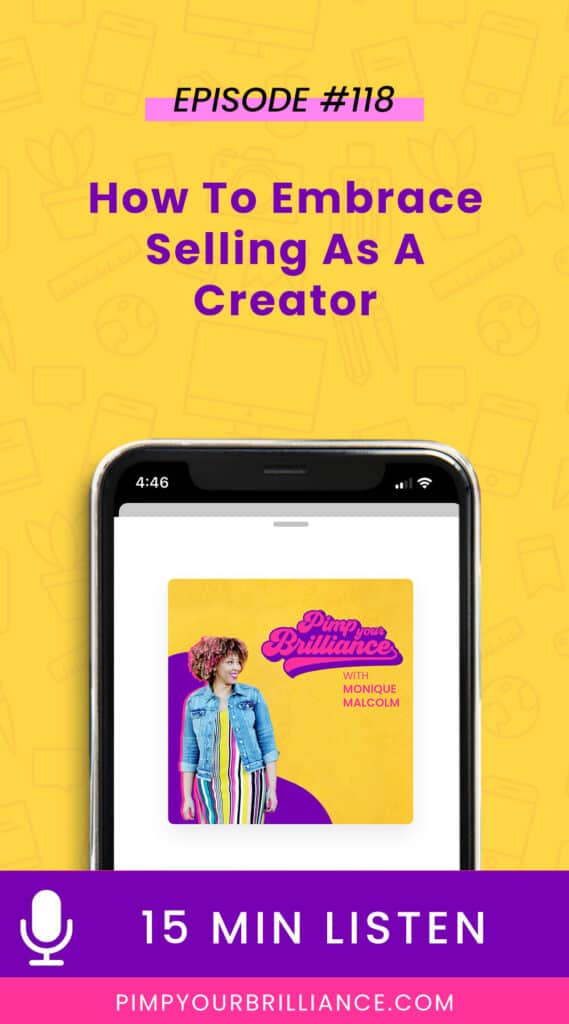
This episode is a part of the Brilliant Biz Bootcamp💡 podcast series designed to teach you a concept that is essential in monetizing your creative business. Each episode features a companion resource for further exploration. You can gain access to the resources by entering your email address below. 👇🏽👇🏽[convertkit form=2532175]
We’ve all been burnt by a poor sales experience. It probably doesn’t take too much effort to recall an experience you’ve had with a salesperson who was too pushy, a little sleazy, and wouldn’t take “No” for an answer. That experience probably left you wanting a shower after it was over.
Now you’re a creative business owner and selling is a part of the deal. Logically you know that selling is necessary but you’re so afraid of becoming a pushy salesperson. So much so that your desire not to be a bad salesperson has made you resent selling altogether. You rarely sell or push your offers because you don’t want to be “that guy”.
Listen, I get it! If you don’t have the right mindset about selling, it can feel very uncomfortable or “too sales-y”. A lot of creators really struggle with selling and it limits their ability to grow their business.
Let’s change that.
In this episode, I’m digging into how to embrace selling as a creator. Selling doesn’t have to feel icky, create guilt, or cause shame. That’s why I’m sharing a few tips to help you reframe how you think about selling so that you can learn to embrace it.
How To Embrace Selling
Before we go any further, let’s take a quick test. I call this the ‘slimy salesperson test’. It’s simple.
Raise your hand if:
- You want to scam people.
- You don’t genuinely want to help people.
- Your business solely exists to drain your customers of every dollar they have.
- You don’t plan on offering ANY value with your products or services.
- You want to pressure people into buying things that might not be right for them.
If you didn’t raise your hand for any of the statements, you are NOT a slimy salesperson. Congratulations! Your permission to sell has been granted.
What is Selling?
The Hubspot Blog defines selling as “any transaction in which money is exchanged for a good or service.”
I like to think of selling as… “an exchange of value”.
A seller offers something of value and if that thing has value for the buyer, they come to an agreement and exchange that value.
For example…
✔ If I want to learn hand lettering but I don’t know where to start, I can take a hand lettering class. The class instructor will teach me lessons in hand lettering in exchange for money.
✔ If I needed a website, I could hire a web developer to build my site in exchange for an agreed-upon amount.
✔ If I need a ride to the grocery store, I can call an Uber to take me in exchange for a fee.
In every instance, there is an exchange of value. I’m getting a good or service that I need and the other party is receiving the money that they need.
📍Pro tip: Selling works best when both parties participate in a fair value exchange.
It’s not selling at all costs, instead, you are focusing on how what you have to offer can add value or help your customer. That’s it!
Question Your Money Stories
So how do you begin to embrace selling as a creator? One way is to determine how much of your mindset and beliefs around selling are influenced by your personal money stories. Your money stories are your beliefs and views about money.
Negative money stories plague creative business owners and cause a lot of issues when it comes to selling. Many of these stories were formed during childhood and contradict the mindset needed to sell.
Stories like…
- Money is evil.
- People with money are greedy.
- No one will be able to afford to pay me.
- It’s wrong to want money, especially a lot of it.
Do you actually believe these stories are true for you? While they may have felt true to your caregivers, you’ve likely adopted the same stories without questioning where they’ve come from. Let go of stories that don’t belong to you.
You need to explore your money stories to determine if you accept them. If you don’t, it’s time to uncover which ones are interfering with your ability to sell successfully. Journaling is a great tool to help you get to the bottom of your beliefs.
A few reflective questions to journal through:
- How was money discussed in your household? Was it good or bad?
- How was your parent’s relationship with money? How has yours been?
- Do you relate money to a negative experience?
- What does money represent to you?
- Is there anything around money that feels shameful or makes you feel guilty?
- When you think about money as a child, does it pull up any strong feelings or memories?
Once you start journaling, dig into your stories, the ideas, and memories that come up. Which of these stories do you know to be false? Which stories affect your thoughts and beliefs about your ability to grow your business?
Pick your top 3 money stories and rewrite them to reflect what you actually believe about money.
Rewritten money stories…
- “Money is evil.” 👉🏼 “Money is a tool. It lets me create things that I want and raises other people up.”
- “People with money are greedy.” 👉🏼 “Having money gives me options and choices. I choose to use it to create a better life for myself, my family, and others.”
Make sure you display your newly rewritten money stories somewhere so that you can revisit them often.
Reframe The Way You Think And Talk About Selling
Another way to embrace selling is to reframe the way you think and talk about it. This is a major!
As I mentioned earlier, your desire not to come across as “too sales-y” has resulted in you selling a lot less than you should be. That’s a gross overcorrection on a key part of your business.
Businesses sell. Point blank. Period.
Stop framing selling as a negative or burdensome experience for your customers. This is weighing you down. Your belief that selling involves taking something away from customers instead of giving them something, is preventing you from seeing how it can be mutually beneficial.
If selling is an exchange of value, then you can reframe it as a way to help your customer achieve a certain outcome. Transformations have value.
That makes your sales process a way to help potential customers make informed buying decisions because you’re providing them with necessary information. There’s nothing slimy about that. I’d argue that you’re providing even more value by making sure that only the right people are spending their money with you.

Here’s a list of common selling hang-ups + reframes…
“I hate selling. I feel bad taking someone’s money.” 👉🏼 “Selling helps fuel my creativity and grows my business. I’m not taking from my audience, I’m making an offer that the right person will be happy to receive.”
“I don’t want to send too many emails during my launch because I will annoy my audience.” 👉🏼 “I’m excited to share my latest offer with my audience and provide them with the information to make an informed buying decision. My message will make it to the right people.”
“I’m afraid that my client’s proposal is too high so the client will think it’s too expensive and reject it.” 👉🏼 “I do my best work when I’m fairly compensated. The right clients will see my value and are happy to accept my offer.”
Now, it’s your turn. Make a list of your most common hang-ups around selling and write a reframe for each one.
Finally…
To truly embrace selling you need to accept these truths:
- There are people for whom your offer is a great fit.
- There are people with a problem you can help solve.
- There are people who you can help achieve success or avoid failure.
If you truly believe in your product or service, it’s your duty to sell it because you’re helping someone. You’re making things more convenient for them, helping them succeed, or shortening their learning curve.
Helping your potential customers see that you are there to resolve a problem for them isn’t being “too sales-y”, it’s being of service.
[convertkit form=2530572]
Pin This👇🏼

